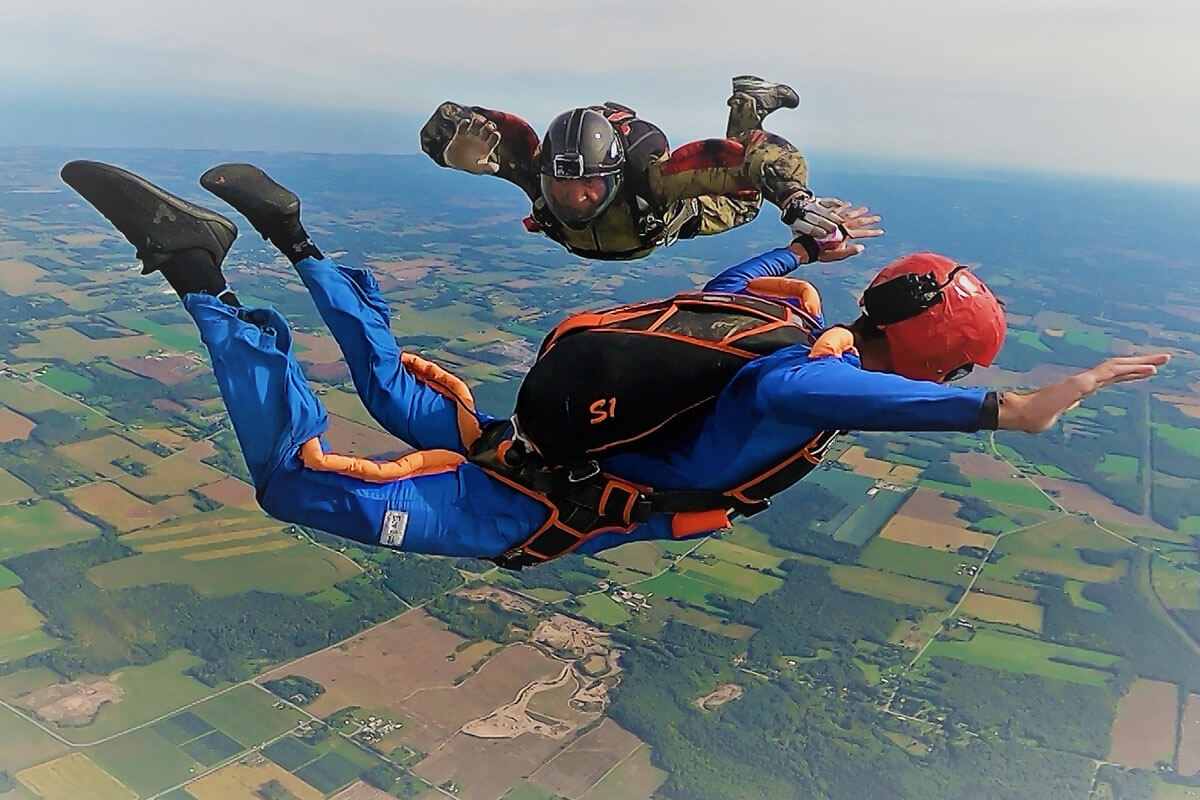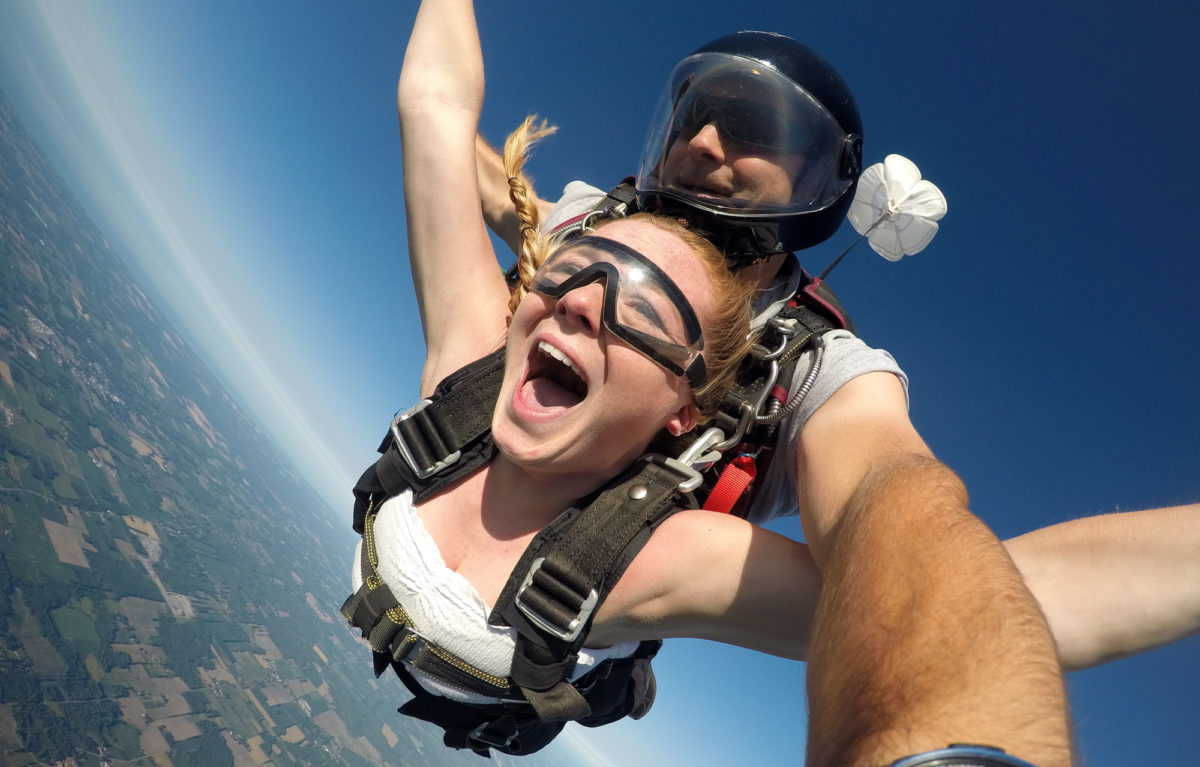The skydiving arch is the most important out of all skydiving positions for tandem students and experienced jumpers alike. Different free-falling poses and skydiving techniques are fun to learn, but each jumper must understand the fundamentals of the arch for a few reasons. The arch is the most natural body position to be in while falling through the sky (a bit ironic, we know), it allows for an ideal deployment of your parachute, and it is regarded as the safest body position during the freefall portion of the skydive.

Why Is The Arch So Important In Skydiving?
Soo … what is the proper skydiving arch? You’ve nailed the textbook skydiving arch when your belly is pointed to the earth, hips slightly pushed forward, your chin is up and you’re looking forward to the horizon — like a big ol’ banana. Let’s jump into the specifics of our top three reasons to master the arch!
You were born a natural
In case you forgot, we’re skydivers, so we’re not going to get into a full-blown physics lesson about gravity. However, all things have a center of gravity – think of this as the part of something where the most mass is centered. For humans, it’s our hips! Falling belly-to-earth in the quintessential arched position is the most natural for our bodies, despite doing a very unnatural thing like freefalling through the sky.
Other positions that licensed skydivers undertake include: sitting, standing, back flying, tracking, and flying head down! Being able to orient ourselves into these positions and fly with others in a safety-first atmosphere is sick, but at the end of our freefall we all resort back to the OG arch in time to deploy our canopy.
Ideal Deployment
When it’s time to pitch our pilot chute to initiate deployment of our main parachute, the arch is the ideal position to prevent entanglement with our parachute or its lines. Think about it: the parachute is on our backs and ready to open above us, when in the arch position we are in our most stable pose and at our slowest fall rate.
- What’s fall rate? Fall rate is how fast a skydiver naturally falls – AKA, how fast someone falls in the arch! Fall rate is affected by a couple of factors, including weight, body size, proportion, and drag. All of these things affect our surface area, which affects our fall rate. In a belly-to-earth position, more surface area will be taken up, typically resulting in a slower fall rate, and vice versa. Imagine a 200 lb person with a skin-tight bodysuit falling alongside someone of the same stature and weight in a baggy, loose-fitting jumpsuit. Who will fall faster? The first person! Skydivers can add to or take away from (by wearing tight clothing) their “drag” and fly with jumpers of various shapes and sizes. We can also do a ‘hard arch’ to speed up, or a ‘plank’ to make ourselves bigger and slow down.
Safety and stability
Skydivers often say, “Look good, have fun, safety third!” In actuality, we are always putting safety at the forefront of every single skydive. (We’re a playful bunch; it’s just a joke.) Since our center of gravity — our hips — is closest to the Earth’s gravitational pull compared to the other parts of our body, the arch is our most stable position. Skydivers prioritize certain things during each stage of the jump, from gear up and aircraft exit to landing.
We also have “pull priorities” which include: pull, pull at your predetermined altitude, and pull while stable. Although being stable comes third, it’s pretty dang important! Being stable encourages a smooth canopy opening.
Stability leads to predictability in your deployment, although we’re always prepared for everything that can go wrong, to go wrong. If you’re a spinning meat missile flailing through the sky, you won’t have an ideal opening, and this disorientation can be potentially dangerous for you and others. When in doubt, always go back to the arch!

How Can I Get The Perfect Arch?
Okay, you won’t believe we’re asking you to d this while you’re FALLING THROUGH THE SKY, but the key to a good arch is to ~relax~. Yep, you read that right. There’s even a hand signal used by instructors in freefall to tell students to relax when they notice them tensing up. Tension can come from a multitude of things, such as nervousness. It causes our bodies to de-arch. Our best tip is to listen to your instructor, trust yourself and the process, and HAVE FUN.
On tandem skydives, your instructor is above you doing the biggest arch ever, but it’s still important to help them out! On skydives, the wind is pushing against you at about 120 mph, which makes it much easier to assume the arch position.
- How can I improve my skydiving arch? Do supermans! Yes, those annoying exercises from PE class. Lie on your stomach with your hands by your ears (you should be able to see your hands out of our peripheral vision) and your ankles a bit wider than shoulder width apart. And now … ARCH! Squeeze that booty and those back muscles! Keep your pelvis on the floor (add a pillow here!) and lift your hands and arms, chest, ankles, and knees off the ground by about 6 inches. Noice!
Are you ready to BANANA!? Book your jump today! And don’t hesitate to reach out with questions — we’re here to help you have the best day ever!





